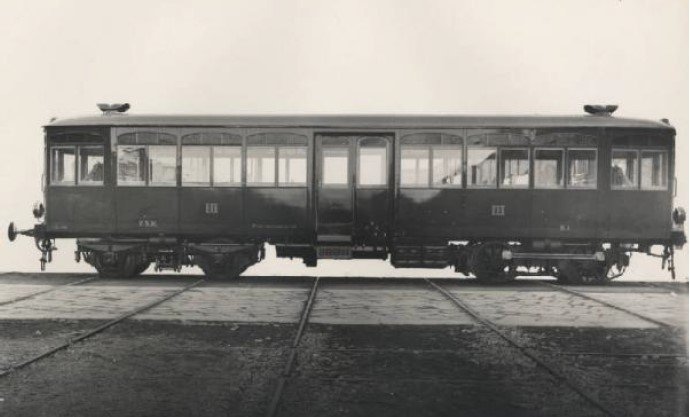The first prototype of the internal combustion railcar ordered and tested by FNM was a petrol vehicle supplied by Breda. Its structure resembled that of the first class coaches delivered the same year. The steel chassis supported a wooden body with “cathedral” style windows and an exterior covered in sheet metal. The roof was wood covered with tarred canvas. It was registered as M1 and was fitted out for third class service only. An access vestibule was present at the centre of the body, closed by two slam doors. It was equipped with two 50 hp petrol motors which, via a shared 4-speed gearbox, acted only on the internal axle of the motor bogie. This was coupled via a connecting rod to the other axle on the same bogie to increase the force. The opposite bogie was of the FOX type and was load-bearing only. This vehicle was withdrawn from passenger service in 1930; in 1937 it was fitted with mobile scaffolding on the roof and converted to a service vehicle for the maintenance of the overhead line.
M1 and MD 500

- Progettazione: 1924 (M1)
- Costruzione: 1924
- Esercizio: 1924 - 1930
- Massa a vuoto: t. 31,6
- Rodiggio: 2 + B
- Costruttore: BREDA - Milano
- Lunghezza fuori tutto: 15.360 mm
- Freno: ad aria compressa
- Motori: n. 2 a benzina
- Velocita massima: Km/h 60
- Interperno carrelli: 8.300 mm
- Passo carrelli: 2.440mm
- Ruote Ø: 980 mm
- Altezza imperiale: 3.370 mm
- Alimentazione: benzina
- Design date: 1924 (M1)
- Build date: 1924
- Service date: 1924 - 1930
- Service mass: 31.6 tons
- Wheel arrangement: 2 + B
- Builder: BREDA - Milan
- Overall length: 15,360 mm
- Braking system: compressed air
- Engines: 2 petrol
- Maximum speed: 60 km/h
- Distance between bogie centres: 8,300 mm
- Bogie wheelbase: 2,440mm
- Wheel Ø: 980 mm
- Roof height: 3,370 mm
- Fuel: petrol
In 1931, as soon as the M1 was withdrawn, two rail buses, registered as Md ½ - 1 and 2 and later classified as Md 500-01 and 02, were supplied by Carrozzeria Varesina and put into service on a trial basis. The body was an all-metal automotive type, similar to that of a small bus; the chassis was an OM 5BLDPL automotive chassis similar to those used for trucks and coaches of the time. It was a chassis with an exterior hood for the 85 hp motor built by Officine Meccaniche, on licence from Swiss company Saurer. Their interior set-up was very similar to that of 1930s buses, with bench seating arranged in two rows, with two seats each, and a central aisle. There were two slam access doors on each side. The wheels had no tyres and were fitted with railway-style rims; the vehicle was also equipped with sandboxes and small buffers at the ends. The front wheels were locked when travelling on the rail.

